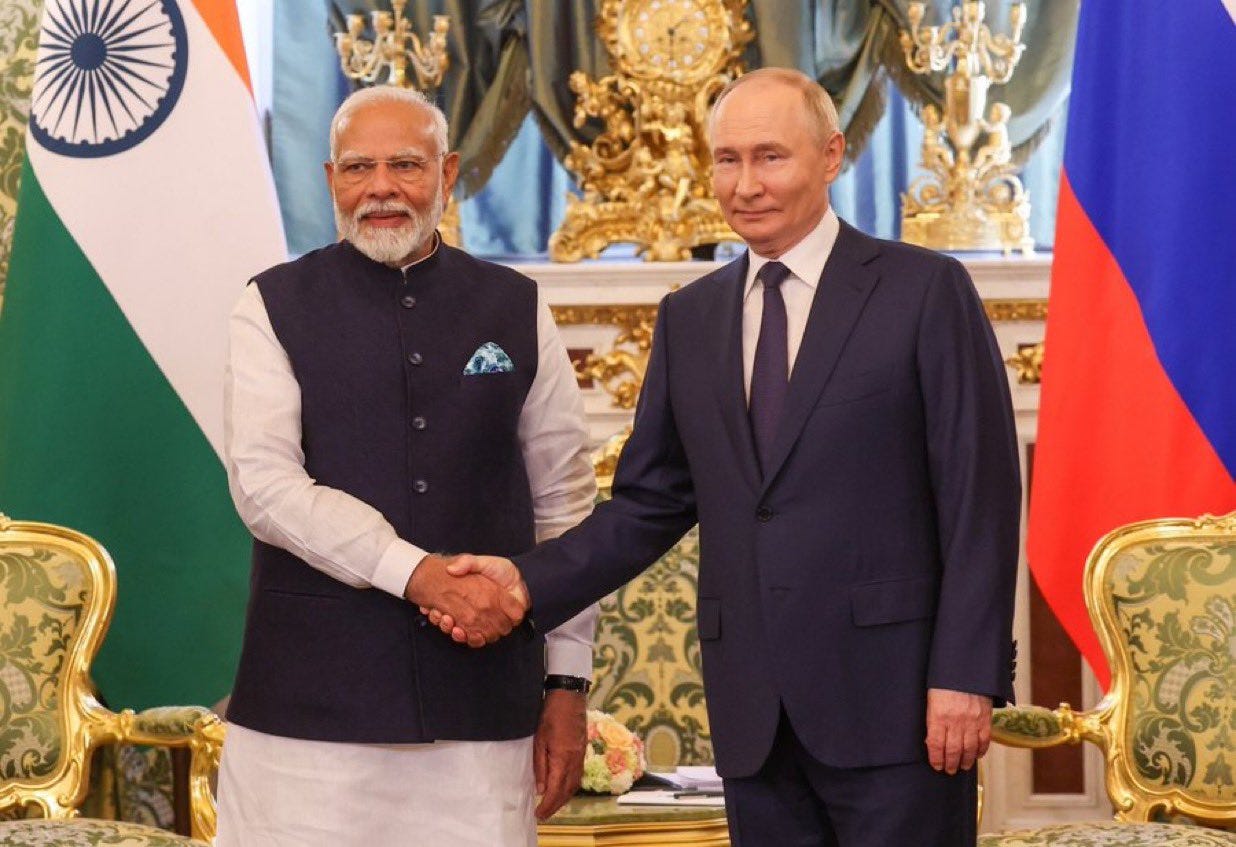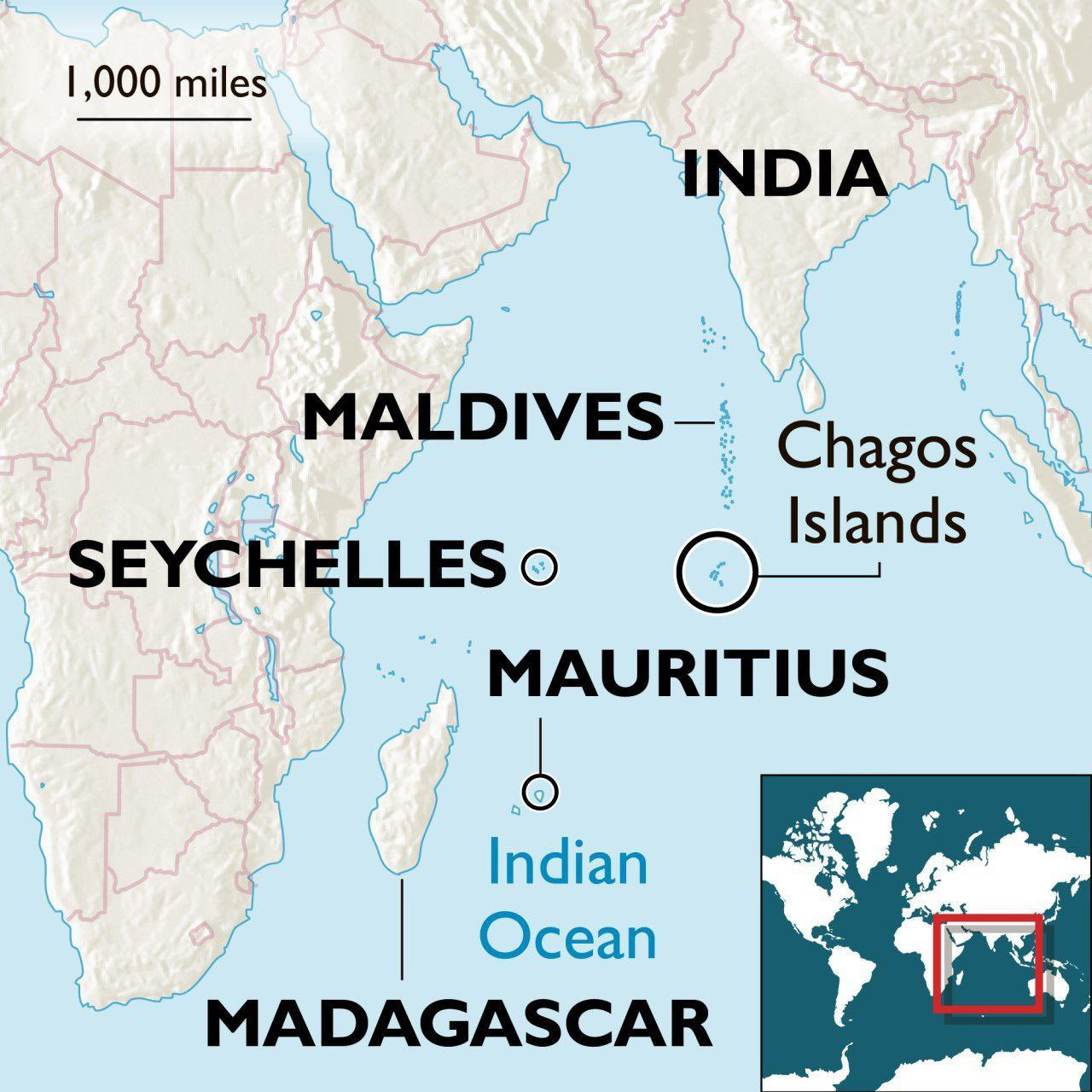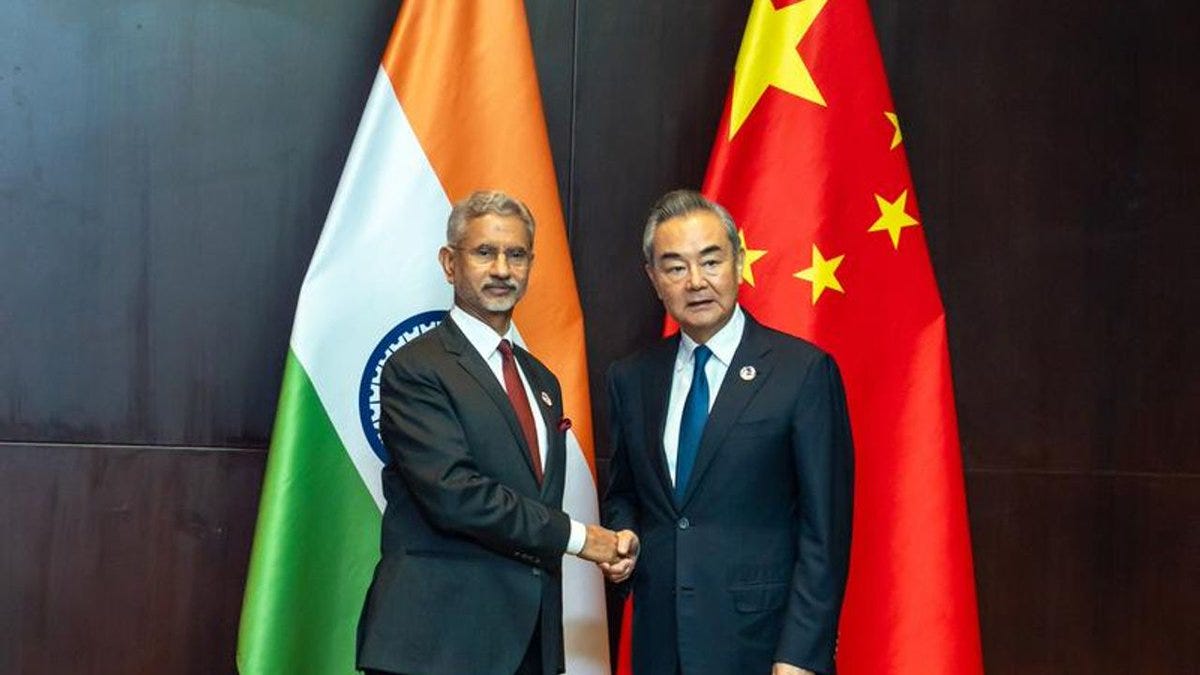Why the collective West is furious with Modi’s Moscow visit—some underlying home truths
+. India and China—proud neighbours gear up for a tough reset
Caption: Prime Minister Narendra Modi’s visit to Russia has stirred a hornet’s nest in the collective West
US Criticism
Senior US officials like Donald Lu and Ambassador Eric Garcetti have slammed Modi’s visit to Moscow.
The US is frustrated with India’s strategic autonomy and refusal to align with Western interests especially in Ukraine.
Role of Globalists
The US animosity towards India runs deep. Highly influential Globalist icons such as George Soros are ideologically opposed to Modi’s India, alleging that the India Prime Minister pursues a Hindu-nationalist agenda and bonds with business figures like Gautam Adani.
Globalist critiques are seen as efforts to undermine Modi’s political and economic influence.
Friction between India and the West is expected to grow because of India’s Independent Foreign Policy
The collective West’s inability to grasp that old rules of global conduct do not apply in a multipolar world is another cause of dissonance in its relations with India.
Piqued by the constant carping by the US officialdom about Indian Prime Minister Narendra Modi’s visit to Russia, India has decided to show the Americans the world’s new playbook.
In response to the attack by Donald Lu, a senior State Department official about Modi’s Moscow visit—the Indian Prime Minister’s first foreign undertaking after he assumed a third term in office—the Indian External Affairs Ministry urged Washington to read the new rules of the multipolar world.
"We must understand that India has a longstanding relationship with Russia that is based on mutuality of interests. In a multipolar world, all countries have freedom of choice. It is essential for everybody to be mindful of and appreciate such realities," the foreign ministry said last week.
https://x.com/hornbilltv/status/1816427433169739948
The back-and-forth between India and the United States mirrors a basic clash of ideologies. Since independence, India has pursued an independent foreign policy, whether it was nonalignment during the heat of the cold war, or pursuit of Strategic Autonomy once the world turned unipolar after the 1991 collapse of the Soviet Union and India’s assertion as a nuclear weapon state seven years later. It is obvious that independence of mind is part of India’s civilizational DNA, which has found expression in various forms at defining moments of its history.
Fast forward to the 21 st century, India’s doctrine of Strategic Autonomy acquired stronger amplitude after the 2008 meltdown of the western economies, which demonstrated a visible decline of western geo-economic heft. The 2008 reality check led to a sharper focus on the G-20 grouping, the rise of the emerging economies coalescing around the BRICS, along with the visible stirring the rest of the Global South, which, as in the case of Africa, is beginning to experience the second phase of decolonisation, especially in the Sahel region.
Caption: Military leaders of Niger, Mali, and Burkina Faso signed a new pact in Niamey, Niger’s capital
The writing on the wall is clear—the multipolar world has arrived and the era of unipolarity that began with the 1989 collapse of the Berlin wall is dead. The rise of the multipolar world has erased Francis Fukuyama’s “end of history” template that he framed after the Soviet Union’s collapse.
The spokesperson of the India’s External Affairs ministry was, in response to Lu’s hubristic statement, was therefore prodding Washington to smell the coffee as in today’s world, power has defused and new rules of the multipolarity are in the midst of being written.
Earlier the Indian external affairs ministry had also locked horns with the Americans over Modi’s Moscow visit, after the US ambassador to India, Eric Garcetti expressed exasperation with India’s fixation with Strategic Autonomy. "I know that India...and I respect that India likes its strategic autonomy, but in times of conflict, there is no such thing as strategic autonomy. We will in crisis moments, need to know each other. I do not care what title we put to it, but we will need to know that we are trusted friends, brothers and sisters, and colleagues in times of need," Garcetti had pitched at a public event, in the context of Modi’s visit to Moscow.
https://x.com/RnaudBertrand/status/1811809999947272653
Beneath the radar, the tiff between India and the US has simmered at an altogether new level of geopolitical contestation. During External Affairs Minister, S. Jaishankar’s a mid-July visit to Mauritius, the visiting minister implicitly called for the removal of a US military base in Diego Garcia—a major US maritime anchor in the Indian Ocean.
On July 16, Jaishankar speaking at a Port Louis press conference was unequivocal in siding with Mauritius’ 40-year claim on Chagos archipelago—a cluster of 60 islands in the Indian Ocean that includes Diego Garcia. “As we look at our deep and enduring relationship, Prime Minister (of Mauritius Pravind Jugnauth) I would like to again assure you today that on the issue of Chagos, India will continue its consistent support to Mauritius in line with its principled stand on decolonisation and support for sovereignty and territorial integrity of nations.”
https://x.com/RT_India_news/status/1813199534291624019
Incidentally, Diego Garcia hosts US long range bombers, supplementing the Anderson Air Force base in Guam. Interestingly Diego Garcia, located south of the Maldives, is just 1,796 kilometres from Kanyakumari, India’s southernmost tip.
The friction between India and the US is far from over, and there are deep underlying factors behind it. Since 2020, Globalists—a uber powerful section of the US elite that believes in the formation of a world government by eroding sovereignty of nation states as well as their traditional anchorage—has mounted a massive attack against Modi. Speaking at the World Economic Forum, the globalists’ favourite playground, George Soros, their uncrowned monarch took direct aim at Modi.
Speaking at the World Economic Forum in 2020, Soros said: “The biggest and most frightening setback occurred in India where a democratically elected Narendra Modi is creating a Hindu nationalist state, imposing punitive measures on Kashmir, a semi-autonomous Muslim region, and threatening to deprive millions of Muslims of their citizenship.”
https://x.com/joymatts/status/1220634046998499328
Modi has been in Soros’ cross-hairs ever since. Soros’ name has also cropped up in the hit-job against Gautam Adani, the billionaire who is supposedly on the inside-track with Modi. So, how do the globalists connect with the attack on Gautam Adani, executed through the Hindenburg report, which accused the Adani Group of “brazen stock manipulation and accounting fraud scheme over the course of decades.”?
That’s where the website Adani Watch run by the Australia-based Bob Brown foundation comes in.
Adani Watch, a dedicated website to hound Adani since October 2019 has gone to town to bull-horn the Hindenburg report. In a media release on Jan.27, the blatantly partisan portal says that, “Adani Watch has scrutinised the activities of the Adani Group and related businesses for over three years. The revelations contained in the Hindenburg report are consistent with a pattern of corporate misconduct observed over those years. But the report and initial response to it miss a crucial context that should bear on the thinking of businesses, citizens, and governments: Adani is not working alone.”
The stirrings in Australia against Adani began when he bagged a project for the Carmichael coal mine in 2010. Seven years later, Bob Brown, eventually the founder of Adani Watch, launched a coalition of 13 environmental groups, called Stop Adani Alliance, opposed to Indian billionaire’s Carmichael coal mine, the Guardian reported.
According to the Guardian, Brown had teamed up with Australian Conservation Foundation, 350.org.
It is through 350.org, the globalist connection with the anti-Adani alliance gets established. The t 350.org, is reportedly heavily funded by the Tides foundation. In turn, George Soros has funded the Tides Foundation.
Speaking at the Munich Security Conference in February 2023, Soros tried a double-strike against both Adani and Modi during his speech.
https://x.com/thehawkeyex/status/1626436906203623424
He said that the woes of Adani will weaken PM Modi as the two are “close allies.” “...Modi and business tycoon Adani are close allies; their fate is intertwined. Adani Enterprises tried to raise funds in the stock market, but he failed. Adani is accused of stock manipulation and his stock collapsed like a house of cards. Modi is silent on the subject, but he will have to answer questions from foreign investors and in parliament. This will significantly weaken Modi’s stranglehold on India’s federal government and open the door to push for much needed institutional reforms. I may be naïve, but I expect a democratic revival in India.”
https://www.georgesoros.com/2023/02/16/remarks-delivered-at-the-2023-munich-security-conference/
Soros has also been highly critical of India’s Russia connection—a theme that has resonated in the Biden administration, which is reportedly infested with globalist acolytes. India, Soros said “buys a lot of Russian oil at a steep discount and makes a lot of money on it.”
It is clear that US pressure on India will only mount, especially if globalists once again are in the driving seat with Kamala Harris as the next President.
Caption: US Vice President Kamala Harris with Alex Soros, son of George Soros
Conversely, the contestation within the multipolar space is expected to dip if Donald Trump becomes the next President of the US at the November elections. In fact, his victory could open the door of a stronger multipolar world, with the US, arguably, among its strongest poles. (End)
India and China—proud neighbours gear up for a reset
Caption: India’s External Affairs Minister S. Jaishankar and his Chinese counterpart Wang Yi declared their intent to ease border tensions between the two Himalayan neighbours during a recent meeting in Laos
Background of Estrangement
The relationship between India and China has been strained since the June 2020 Galwan clash, which resulted in casualties on both sides.
Following the clash, people-to-people contacts dwindled, direct flights were canceled, and Chinese FDI into India was restricted.
Reasons for Renewed Engagement
Economic Decline: China's economy grew at 4.7% in Q2 2024, below the projected 5%. This economic slowdown has prompted China to seek new opportunities in Asia, including engaging with India.
Geopolitical Considerations: Both countries face significant geopolitical challenges. China needs to manage its military resources effectively, particularly regarding potential conflicts in the South China Sea and Taiwan. India’s expensive troop deployment in Ladakh and the potential for a two-front war with Pakistan make continued border tensions undesirable.
Shared Aspirations: Both nations have ambitious goals—China aims to become the world’s leading superpower by 2049, while India aspires to become a fully developed nation by 2047. Engaging in a destructive war would be counterproductive to these goals.
India and China seem set for a new round of engagement after a gap of nearly four years, when only trade conspicuously flourished, but all other aspects of geo-economic interaction were virtually frozen. After the June 2020 Galwan incident of an unarmed border clash between Indian and Chinese troops, which led to casualties on both sides, people-to-people contacts between the two countries almost dried up. Direct flights were cancelled and Chinese FDI into India ran aground after New Delhi put extra monitors on flow on foreign investment by neighbouring countries, including China.
But after years of economic estrangement, a new round of pragmatic engagement seems to be ending this half-a-decade hibernation.
There is reason why New Delhi and Beijing are now ready to talk. First, the Chinese economy in the 2nd quarter of the 2024 has declined to 4.7 percent from the projected 5 percent. The Chinese have taken notice of the red flag. With geopolitics coming in the way of a geo-economic relationship with the West, the Chinese have discovered Asia’s growing importance. And within the world’s largest continent, a rising India, already the world’s fifth largest economy, is a worthy destination.
Second, from a geopolitical perspective, the border standoff with India serves no one’s interest, especially at a time when China is facing headwinds, and would need to free-up troops for possible deployment in the South China Sea as well as Taiwan. For India, maintaining troops in such large numbers in the unforgiving mountainous terrain of the Sino-Indian border in Ladakh is an expensive affair. Besides, forward deployment of Chinese troops raises the theoretical possibility of a two-front war, with Pakistan, China’s all-weather ally opening a second front. Any military escalation in these barren heights would open the pathway of a nuclear conflict, which China and India can ill-afford, especially at a time when both are focusing on realising their big dreams.
For instance, the Chinese want to become the world’s unrivalled superpower by 2049, marking a centenary of the formation of the People’s Republic of China (PRC). On his part, India’s Prime Minister Narendra Modi has declared that India will become Viksit Bharat of a fully developed nation by 2047—the year when independent India turns 100. When both countries are determined to climb such lofty heights, fighting a destructive war would be simply self-defeating.
Third, there is an ever-increasing realisation in the circles of India’s ruling party, the Bhartiya Janata Party (BJP), that a shortfall in job creation among the youth was a major factor resulting in the below par showing of the Party in the latest parliamentary election. But a jobs windfall is co-linked with investments, including Foreign Direct Investment (FDI). That can flow big-time into India from China, provided there is a policy shift in both New Delhi and Beijing.
In its hard-headed thinking on re-engaging China, the Indian side seems to have made up its mind. New Delhi wants Chinese investments in India, rather than India’s integration in a China-centred supply chain. In its latest annual Economic Survey, an official document, India has signalled its broad reboot strategy with China. “India faces two choices to benefit from a China plus one strategy: it can integrate into China’s supply chain or promote FDI from China.” Of these “focusing on FDI from China seems more promising…”
In a recent article, Ravi Bhoothalingam a corporate coach and an Honorary Fellow of the Delhi based Institute of Chinese Studies, points out that India can emulate the example of countries like Hungary and Poland, which have invited Chinese companies such as BYD, battery-maker CATL and upstream suppliers to invest and produce EVs, batteries and a whole EV ancillary eco-system in partnership with European companies.
https://x.com/The_AMEGroup/status/1755089469483712652
“This collaborative model not only creates local employment but allows European producers room to modernise and develop their own businesses into niches of globally competitive expertise. It is an approach that India could well consider.”
https://thewire.in/south-asia/could-china-help-india-achieve-viksit-bharat
He further adds that China’s would revitalise India’s manufacturing industry, create jobs and accelerate the fight against climate change on account of Beijing’s head start in the green economy. “Let us welcome all companies – whether from China, the West or elsewhere – to partner us on Indian soil and create prosperity for our citizens. However, he points out that for the sake of clarity, the government should nail a limited ‘negative list’ where any Chinese involvement is not permitted on security grounds, and then move on.








